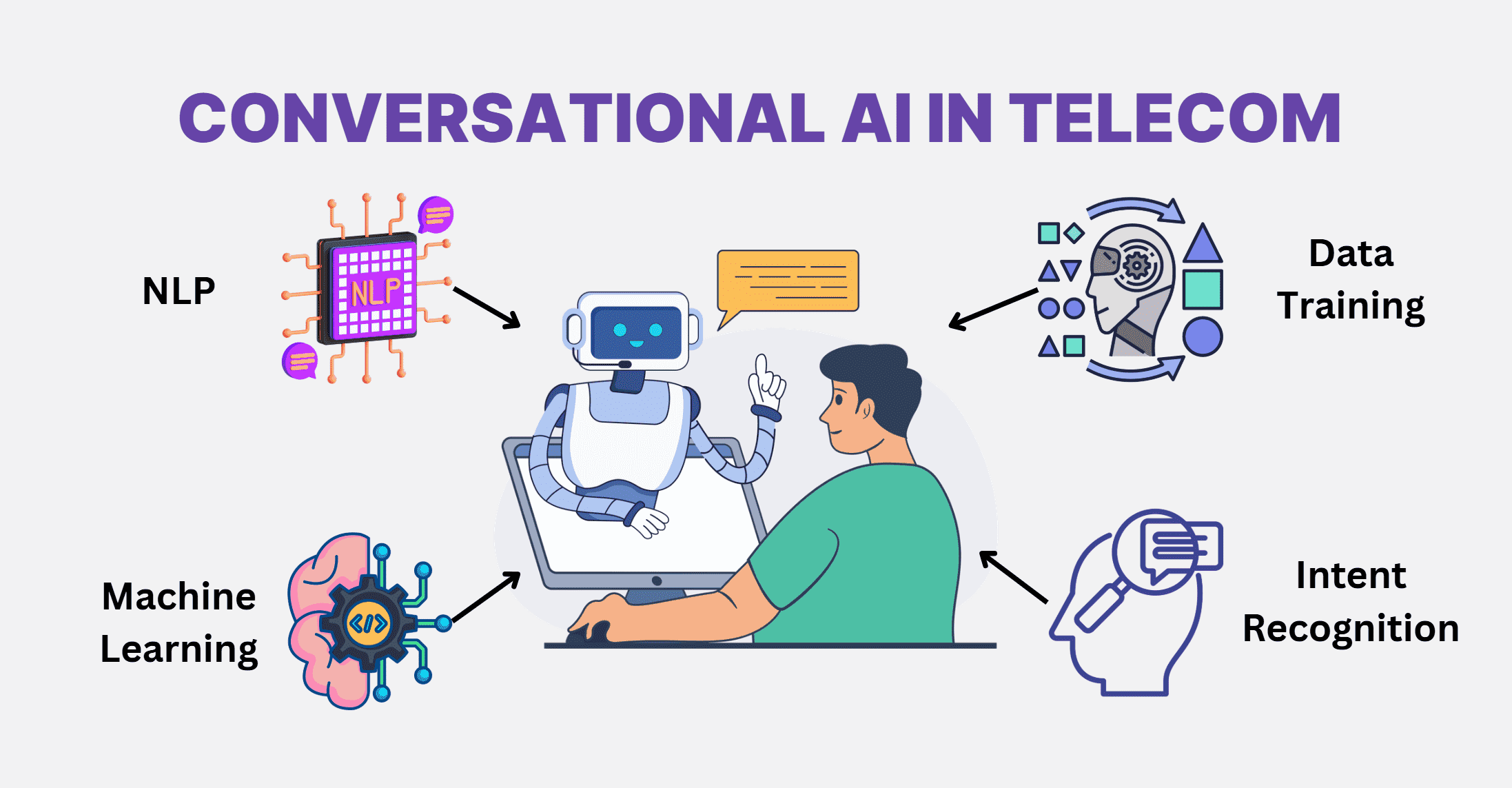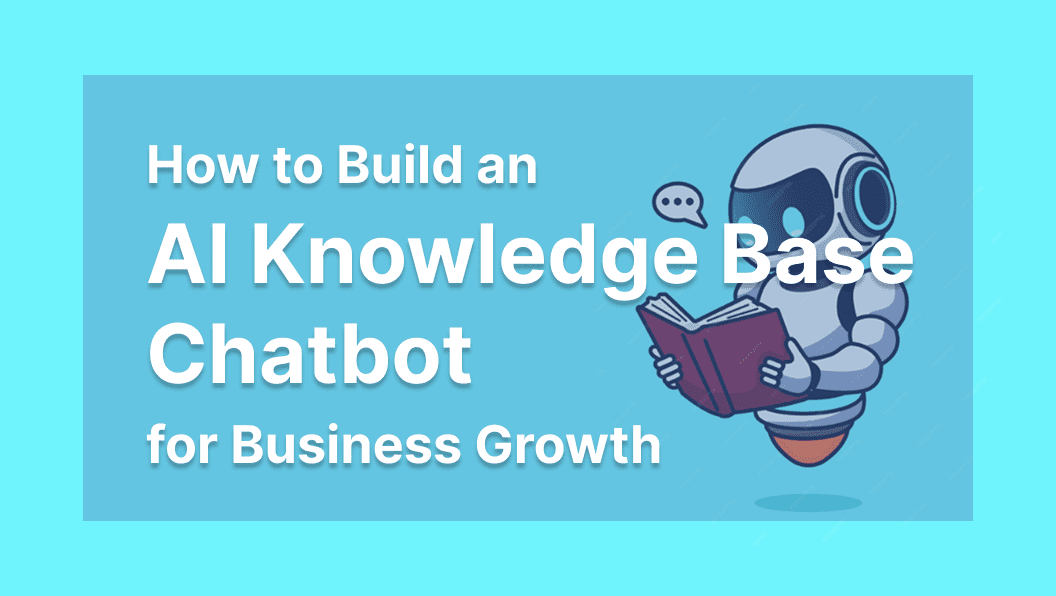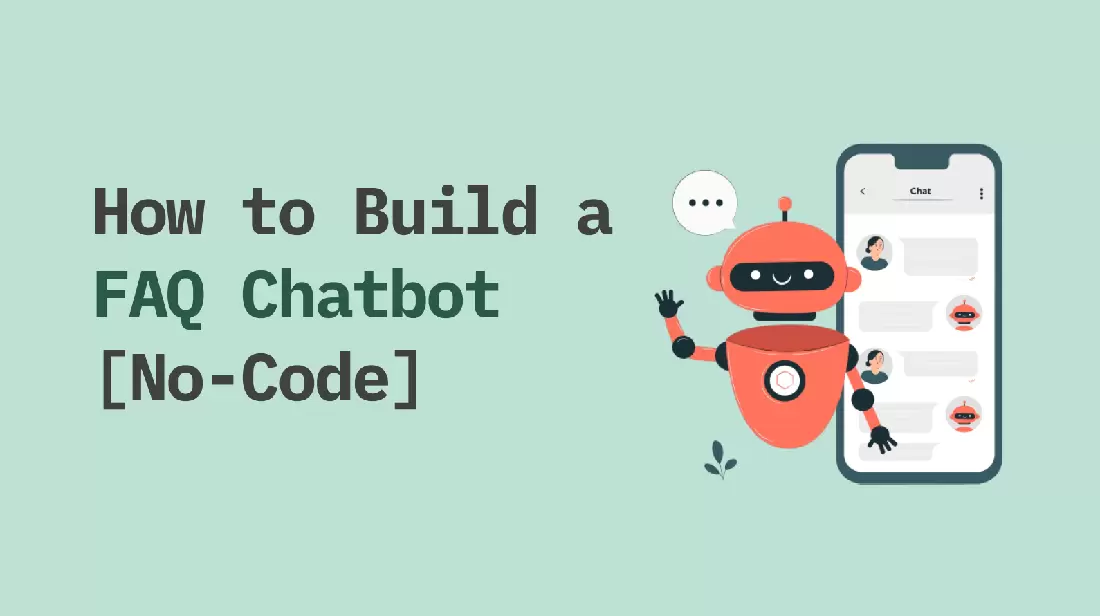Conversational AI is the need of the hour in the telecom industry. Not only can it automate most of the tasks and reduce the burden on human representatives but also take customer experience to the next level.
Here’s a detailed guide on the use of conversational AI in telecom, its purpose, how it solves telecom issues, and how you can get started with it. From idea to implementation, we have explained everything you should know.
Part 1: What is Conversational AI in Telecom?
Conversational AI is a type of technology that lets machines talk with people in a way that feels natural. You've probably seen it when a chatbot answers your question on a website or helps you check your account through a phone menu.
In telecom, this is especially useful because companies serve a huge number of users every day. Customers might reach out through phone, SMS, apps, websites, or social media. They often switch between these channels too, which makes it harder to keep up and deliver smooth support.
To handle all this, conversational AI uses tools like Natural Language Processing (NLP) to understand what people are saying. It also uses intent recognition to figure out what the customer actually wants. Once it understands the request, it gives a relevant response based on what it has learned or stored.
Put simply, conversational AI helps telecom companies talk to more customers, across more channels, and do it faster and more efficiently.

Part 2: Why Telecom Needs Conversational AI?
We have already discussed that the telecom sector deals with a lot of customer requests. The number could be hundreds to millions per day, depending on the size of the customer base.
If a telecom company handles all these calls through human agents, it will be extremely costly. It will need a huge number of representatives 24/7 to respond to customer calls. But even then, the company has to face multiple challenges, including wait time, poor user experience, and scaling issues.
Opting for conversational AI would be the best solution. AI agents handle a large volume of customer requests efficiently, offering fast and consistent responses that improve overall customer experience.
The best part is that conversational AI is cost-effective. It does not require a heavy initial cost, and the running cost is also minimal. That said, it is a great option for telecom companies. It also makes scaling the business easier.
The telecom industry can use AI for multiple applications, such as:
- Account and billing management
- Sending automated notifications to customers
- Educating customers and promotion campaigns
- Technical support and troubleshooting
- Activation and deactivation of lines
- Customer retention and churn management
That’s not it. Conversational AI can solve many telecom challenges. Let’s see how.
Part 3: How Conversational AI Solves Telecom Challenges
# Massive Number of Requests
Conversational AI tackles the most difficult challenge of the telecom industry, which is handling a massive number of customer requests.
AI chatbots are available 24/7 across multiple channels. Whenever a customer interacts with them on the website, social media, or messaging application, they understand the query and the intent behind it. In no time, they pull up a personalized answer through their knowledge base and previous learnings.
It handles around 70% of the customers' requests, which saves the time of the human representatives for more important tasks. Only the requests that need human intervention are seamlessly handed off. That said, the telecom company requires fewer representatives to handle a massive number of requests as AI does most of the job.
Due to the ability to handle a large number of requests at a time, telecom businesses can rely on them and expand their services and even go global.
# Fragmented Customer Journey
Telecom companies offer multiple contact options to customers. They can get in touch through the helpline number, email, social media, messaging apps, etc.
It is great for customers to select a platform according to their convenience. However, it creates multiple issues for the company. If a customer uses multiple platforms for contacting customer support, it will be difficult to understand the journey.
Conversational AI is capable of dealing with a fragmented customer journey on various platforms. It can understand journeys on all platforms and respond accordingly. It helps in understanding the customer's intent and needs for better resolution.
# Different Languages
When dealing with a diverse customer base, companies need to hire customer representatives for different languages. It increases the operational cost to a great extent, especially if the company targets multiple regions and countries.
Conversational AI can respond in multiple human languages. Most chatbot platforms offer dozens of languages, which helps in catering to a massive audience. Thus, there is no need to hire representatives who can speak different languages and establish multiple centers for different regions.
# Wait Time
A common problem that customers face is the wait time. They need to wait for a long time in a queue to speak to a representative.
Conversational AI eliminates wait time by providing instant replies and solutions. The AI can handle most of the customer queries and offer customized replies instantly.
Chatbots operate continuously, handling large volumes of queries without human limitations. And if the matter is critical, the issue is escalated to a customer service agent.
Part 4: Key Benefits of Using Conversational AI in Telecom
Reduced Operational Cost: Conversational AI reduces the operational cost of the telecom industry by automating customer support. It solves a major problem and saves a lot of money.
Improved Customer Experience: Customers prefer to get their issues resolved and questions answered ASAP. The AI provides fast responses, resolves most issues quickly, and escalates complex matters when needed.
Churn Reduction: Conversational AI reduces churn in the telecom industry to a great extent. It makes customers happy by offering timely solutions. That’s why customers do not want to leave the service.
Personalized Response: AI chatbots do not answer like a traditional bot. They curate personalized responses according to the customer's intent and needs. They offer better resolutions to customer issues.
Better Operation Efficiency: Conversational AI improves the efficiency and productivity. It automates most of the redundant tasks and saves the time of human representatives for more important tasks.
Valuable Data Insights: It collects valuable data from customers and gives a clear insight into the performance. It helps in improving customer service, marketing, sales, etc. The detailed insights help in making data-backed decisions.
Multilingual Support: The AI supports multiple languages. It can translate in real-time and offer responses in the desired languages. Thus, it can help in offering customer support to a wider audience belonging to different regions and nationalities.
Higher Revenues: Conversational AI can boost the revenues of the telecom industry. Firstly, it improves the service and overall customer experience. Thus, old customers do not leave and new customers prefer to opt for the service.
Part 5: Real-World Use Cases
So, what can conversational AI actually do in the telecom world? Here are some real-life ways it helps both companies and customers every day.

1Account and Billing Management
Customers often ask about bills, charges, or account status. Conversational AI can instantly answer these routine questions, taking the pressure off human agents.
2Technical Support and Troubleshooting
When users face issues like slow internet or no signal, the AI can suggest quick fixes, share how-to links, or walk them through steps like restarting a device. If the problem remains, it hands things over to a support agent.
3Proactive Customer Updates
The AI can send reminders when a data plan is almost used up or alert users about maintenance or outages. This keeps customers informed and reduces complaints.
4Service Inquiries and Upgrades
If someone wants to explore new plans or activate a service, the AI can guide them through options based on their needs. It also helps qualify leads before passing them to sales.
Part 6: How to Get Started with Conversational AI in Telecom (From Idea to Implementation)
1Planning and Strategy
Before selecting any conversational AI platform, work on the plan and strategy. It will help in selecting a platform according to your needs and applications.
Consider the purpose of choosing conversational AI and the issues you want to solve with it. Your goal could be handling 50% of the customer requests with it or improving customer satisfaction through instant support. Define your goals as it will help in measuring the performance and output.
Build an appropriate team. The AI will handle most of the work, but you will still need human representatives for critical issues.
2Choose the Right Platform
With your goals in place, the next step is to pick a platform that can grow with your business. In telecom, that means supporting high volumes of customer interactions, working across multiple channels, and delivering fast, reliable automation.
GPTBots.ai is one such enterprise-grade solution. It helps you build no-code AI agents for customer service, sales, and internal operations—while making it easy to integrate with your existing tools.

Key Features Include:
- AI Customer Support: Automates up to 90% of inquiries with natural, multilingual replies and cuts service costs significantly.
- AI Sales Assistant: Handles lead qualification, syncs with your CRM, and engages prospects via WhatsApp, Facebook, and more.
- Enterprise AI Search: Gives staff and agents instant answers by connecting to internal data, APIs, and documents.
- AI Data Insights: Turns plain-language questions into SQL queries for instant, no-code analytics.
- No-Code Builder & Control: Build agents with templates, manage knowledge bases flexibly, and fine-tune response logic with Flow-Agent.
- Multi-Agent Capability: Launch multiple task-specific agents that work together in complex workflows.
3Development and Training
Once the chatbot is trained and tested, it can be integrated across your selected channels — whether it's your website, app, or messaging platforms.
With sufficient business data and usage examples, the AI can continuously improve, eventually managing the bulk of repetitive tasks and customer inquiries autonomously.
A well-deployed conversational AI system not only lightens the load for human agents but also ensures scalable, high-quality support at all hours.
4Deploy and Test
Once the chatbot is ready, integrate it with your system and deploy it on the website, social media, or the channels you have selected.
Test the response of the chatbot. Initially, you might need to train the chatbot a lot for better responses. The more data you offer, the better it is. Once it is trained and tested, it is ready to handle and automate most of the tasks.
Conclusion
Conversational AI is the key to staying ahead of the competition in the telecom sector. It is the need of the hour to improve customer service and experience. It can solve critical telecom issues and reduce operational costs. If you are looking for a conversational AI platform, you can go with GPTBots. It’s a complete no-code chatbot building platform for enterprises. It can automate customer support, sales development, and other tasks on multiple channels to improve customer experience and boost business growth. Sign up today and get 100 free credits every month.







